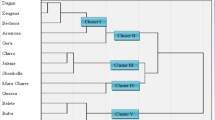Summary
Host plant resistance is an important component to the management of potato late blight,Phytophthora infestans (Mont.) de Bary. Assessment of potato lines (Solanum tuberosum L.) with various levels of resistance toP. infestans (US8, A2 genotype) were evaluated in field trials, greenhouse controlled environment chambers and inoculated tuber reactions. Five lines (AWN86514-2, B0692-4, B0718-3, Jacqueline Lee, and B0288-17) with strong foliar resistance to late blight were identified in these inoculated field trials. Greenhouse controlled environment chamber studies allowed resistant and susceptible lines to be distinguished, but the 1998 greenhouse results did not correlate well with field data. Four lines (A084275-3, Bzura, MSG007-1, and MSG297-4RD) evaluated by a digital image analysis technique demonstrated tuber resistance based upon average reflective index values in the inoculated tuber studies. Tuber resistance did not correlate with field foliar resistance. Based upon these results, field assessment of foliar reaction toP. infestans provides the best measure for assessing late blight resistance in potato. Tuber resistance to late blight can be identified among lines with varying levels of foliar resistance.
Similar content being viewed by others
References
Black, W., 1970. The nature and inheritance of field resistance to late blight (Phytophthora infestons) in potatoes.American Potato Journal 47: 279–288.
Colon, L.T., DJ. Budding & J. Hoogendoorn, 1995. Breeding for foliar resistance toPhytophthora infestons in potato: The influence of test conditions on the results of screening for field resistance. In: L.J. Dowley, E. Bannon, L.R. Cooke, T. Keane & E. O’Sullivan (Ed.),Phytophthora infestans 150. Boole Press Ltd., Dublin, Ireland, pp. 282–288.
Deahl, K.L., S.P. DeMuth, S.L. Sinder & A. Rivera-Pena, 1995. Identification of mating types and metalaxyl resistance in North American populations ofPhytophthora infestans.American Potato Journal 72(1): 35–50.
Dorrance, A.E. & D.A. Inglis, 1997. Assessment of greenhouse and laboratory screening methods for evaluating potato foliage for resistance to late blight.Plant Disease 81: 1206–1213.
Dorrance, A.E. & D.A. Inglis, 1998. Assessment of laboratory methods for evaluating potato tubers for resistance to late blight.Plant Disease 82: 442–446.
Douches, D.S., W.W. Kirk, K. Jastrzebski, C. Long & R. Hammerschmidt, 1997. Susceptibility of potato varieties and advanced breeding lines (Solanum tuberosum L.) toPhytophthora infestans (Mont.) de Bary in greenhouse screenings.American Potato Journal 74: 75–86.
Fry, W.E. & S.B. Goodwin, 1995. Recent migrationsof Phytophthora infestans. In: L.J. Dowley, E. Bannon, L.R. Cooke, T. Keane & E. O’Sullivan (Ed.),Phytophthora infestans 150. Boole Press Ltd., Dublin, Ireland, pp. 89–95.
Fry, W.E. & S.B. Goodwin, 1997. Re-emergence of potato and tomato late blight in the United States.Plant Disease 81: 1349–1357.
Goodwin, S.B., R.E. Schneider & W.E. Fry, 1995. Use of cellulose-acetate electrophoresis for rapid identification of allozyme genotypes ofPhytophthora infestans.Plant Disease 79: 1181–1185.
Goodwin, S.B., C.D. Smart, R.W. Sandrock, K.L. Deahl, Z.K. Punja & W.E. Fry, 1998. Genetic change within populationsof Phytophthora infestans in the United States and Canada during 1994 to 1996: Role of migration and recombination.Phytopathology 88: 939–949.
Haynes, K.G., D.H. Lambert, B J. Christ, D.P. Weingartner, D.S. Douches, J.E. Backlund, G. Secor, W. Fry & W. Stevenson, 1998. Phenotypic stability of resistance to late blight in potato clones evaluated at eight sites in the United States.American Journal of Potato Research 75:211–217.
Helgeson, J.P., J.D. Pohlman, S. Austin, G.T. Haberlach, S.M. Wielgus., D. Ronis, L. Zambolim, P. Tooley, J.M. McGrath, R.V. James & W.R. Stevenson, 1998. Somatic hybrids betweenSolanum bulbocastanum and potato: a new source of resistance to late blight.Theoretical and Applied Genetics 96: 738–742.
Inglis, D.A., D.A. Johnson, D.E. Legard, W.E. Fry & P.B. Hamm, 1996. Relative resistances of potato clones in response to new and old populations ofPhytophthora infestans.Plant Disease 80: 575–578.
Kirk, W.W., B.A. Niemira, J.M. Stein & R. Hammerschmidt, 1999. Late blight (Phytophthora infestans Mont. De Bary) development from potato seed-pieces treated with fungicides.Pesticide Science 55(12): 1151–1158.
Kirk, W.W., K.J. Felcher, D.S. Douches, B.A. Niemira & R. Hammerschmidt, 2001. Susceptibility of potato (Solanum tuberosum L.) foliage and tubers to the US8 genotype ofPhytophthora infestans. American Journal of Potato Research 78: 319–322.
Niemira, B.A., W.W. Kirk & J.M. Stein, 1999. Screening for late blight susceptibility in potato tubers by digital analysis of cut tuber surfaces.Plant Disease 83: 469–473.
Platt, H.W. & G. Tai, 1998. Relationship between resistance to late blight in potato foliage and tubers of cultivars and breeding selections with different resistance levels.American Journal of Potato Research 75: 173–178.
SAS, 2000. The SAS System for Windows. Software Release 8.01. SAS Institute Inc., Cary, NC, USA.
Schwinn, F.J. & P. Margot, 1991. Control with chemicals. Advances in plant pathology:Phytophthora infestans, the cause of late blight of potato.Academic Press 8: 225–265.
Stewart, H.E., J.E. Bradshaw & R.L. Wastie, 1994. Correlation between resistance to late blight in foliage and tubers in potato clones from parents of contrasting resistance.Potato Research 37: 429–434.
Stewart, H.E., P.H. Flavelle, D.C. McCalmont & R.L. Wastie, 1983. Correlation between glasshouse and field tests for resistance to foliage blight caused byPhytophthora infestans.Potato Research 26: 41–48.
Author information
Authors and Affiliations
Corresponding author
Rights and permissions
About this article
Cite this article
Douches, D.S., Kirk, W.W., Bertram, M.A. et al. Foliar and tuber assessment of late blight (Phytophthora infestans (Mont.) de Bary) reaction in cultivated potato (Solanum tuberosum L.). Potato Res 45, 215–224 (2002). https://doi.org/10.1007/BF02736116
Accepted:
Issue Date:
DOI: https://doi.org/10.1007/BF02736116




